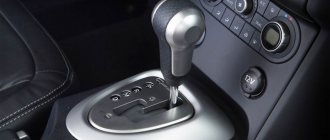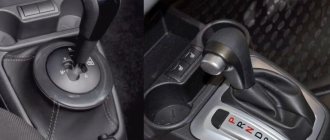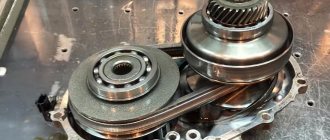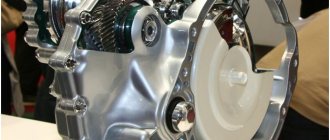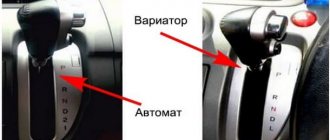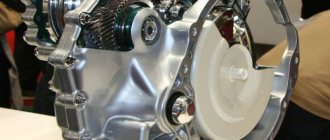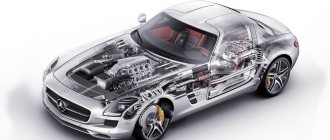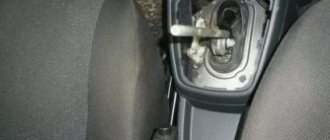When choosing a car, any owner looks at many criteria, among which the question arises: which gearbox to choose. Today, the automotive market can offer 4 types of transmissions:
- Mechanics;
- machine;
- variable speed drive;
- robot.
Each of these boxes has its own advantages and disadvantages, and therefore it is worth considering each of them in more detail and figuring out which of the offered ones is worthy of the greatest attention of buyers.
Hydromechanics
A hydromechanical automatic is the most common type of automatic transmission, found in almost all automakers. Due to their design features, these machines handle high torque better than others, which is why they are most often installed on heavy crossovers and SUVs, as well as on full-size sedans. Essentially, this is a planetary gearbox connected to the engine through a torque converter. Switching of planetary gears in early models occurred hydromechanically, and now - according to electronic commands.
Pivot table
In the end, I want to put all the pros and cons in a table and see who scored the most. Plus is one point, minus is no point, plus and minus are 0.5 points.
| Mechanics (manual transmission) | Automatic (automatic transmission) | CVT (CVT) | Robot (manual transmission), one disc | Robot (manual transmission), two disks | |
| Price | + | — | — | +,- | — |
| Comfort | — | + | + | — | + |
| Reliability | + | + | +,- | +,- | — |
| Savings (fuel) | +,- | — | +,- | +,- | + |
| Development potential | — | + | — | +,- | + |
| TOTAL (in points) | 2,5 | 3 | 2 | 2 | 3 |
Now we are watching the video version.
Robots
Robots can be divided into two groups. A robot with one clutch is a regular “mechanics”, in which the clutch and gear shifting are controlled not by the driver, but by automation. In theory, the reliability of such a unit should be the highest among automatic transmissions. But practice does not confirm this. For example, the editorial Vesta with the robot already had three clutches with a mileage of less than 45 thousand km. The Easytronic box, which was installed on Opel, tormented its owners with electronic failures. In terms of speed and shifting comfort, a single-clutch robot is the worst automatic transmission. Its main advantage is its low price. Therefore, it is installed mainly on small and inexpensive cars.
Design and operation of the variator
The variator structurally consists of:
- driving/driven pulleys, shafts;
- steel belt;
- starting clutch (centrifugal, multi-disc, electromagnetic, torque converter);
- planetary gear satellite;
- oil pump;
- bearings;
- hydraulic unit;
- crankcase with magnets for filling transmission fluid;
- differential;
- planetary gearbox.
There are several types of variators. The most common among them is the V-belt mechanism. The pulleys in it consist of 2 cone-shaped disks with a slope towards the shaft axis. When moving, they are able to move or move apart.
A metal belt consisting of pushing segments is stretched and clamped between the halves of the variator pulleys (they create rotation by clinging to the body of the cones with a toothed surface). When the pulleys move apart, the belt goes inward, and when brought closer it takes on the shape of a wedge. The gear ratio changes by increasing or decreasing the diameters of the conical disks.
At the beginning of the movement, the cones of the driving pulley diverge, and the cones of the driven pulley converge. As speed increases, the reverse process occurs. As a result, the gear ratio changes downward, the traction force decreases, and the speed on the driven shaft increases.
The software part processes the information and changes the operating mode of the CVT variator. The differential distributes torque to the driving wheels of the car. The oil sump serves as a support and protection for the working mechanisms and is used to store transmission fluid, without timely replacement of which the variator will not last long.
By what signs can you determine that the variator has failed?
Signs of main variator failures:
slipping or inability to move away - malfunctions in the variator control module, a defect in the variator transmission (belt slipping between the pulley cones), malfunction of the torque converter, main drive clutch, electro-hydraulic system;
jumps and jerks during operation - the oil pump pressure relief valve is jammed;
stopping the car - wear on the torque converter pump wheel;
the car is moving in neutral - defects in the electrical wiring, gear selector, variator control module;
A hum unusual for a vehicle is the wear of the cone bearings.
The service life of a CVT variator depends on correct operation and regular maintenance. Manufacturers of CVT transmissions recommend changing the belt and transmission fluid in a timely manner (on average after 40 thousand kilometers).
We invite you to watch a video tip on how to operate a variator.
If you have no experience in solving problems with a variator, you can contact the “Cvariator Repair Center No. 1”. Our specialists will help you diagnose and fix problems in a short time. You can get additional information by calling: Moscow –, St. Petersburg – 8. We accept calls from all regions of the country.
CVT box
CVT device
conclusions
Some measurement results:
| Options | Cars | ||||
| Lada Granta Cross 1.6 AMT | Hyundai Solaris 1.6 AT | Renault Logan Stepway 1.6 CVT | Skoda Rapid 1.4 TSI DSG | ||
| Maximum speed, km/h | 177,0 | 198,3 | 165,2 | 200,0 | |
| Acceleration time, s | 0-50 km/h | 4,7 | 3,9 | 4,2 | 3,5 |
| 0-100 km/h | 13,2/13,6* | 10,9/11,9* | 12,1/13,4* | 9,3/9,7* | |
| 0-150 km/h | 33,6 | 24,8 | 35,5 | 21,1 | |
| on the way 400 m | 18,9 | 17,7 | 18,5 | 16,9 | |
| on the way 1000 m | 34,6 | 32,2 | 34,2 | 30,7 | |
| 60-100 km/h (D) | 7,2 | 5,8 | 7,4 | 4,9 | |
| 80-120 km/h (D) | 8,6 | 7,4 | 9,7 | 6,6 | |
| Run-out, m | from 50 km/h | 646 | 740 | 662 | 633 |
| 130-80 km/h | 888 | 1095 | 890 | 1016 | |
| 160-80 km/h | 1329 | 1646 | 1331 | 1541 | |
| Fuel consumption, l/100km | 9,9 | 9,2 | 9,5 | 8,5 |
* Two-pedal acceleration/foot-shift acceleration (ESP and air conditioning included)
Do you want the convenience of traction control combined with high reliability and acceptable efficiency? Choose the good old hydromechanics with a number of gears of at least six - an alternative to which has never been invented. Which transmission would you choose?
- Test drive Lada Vesta with Jatco CVT and Renault-Nissan engine
- Test drive Lada XRAY Cross with Jatco CVT and Renault-Nissan engine
Keywords: variator | gearbox Lada Vesta | gearbox lada xray | gearbox Lada Granta | gearbox Lada Kalina | Lada Priora gearbox
117
5
Found an error? Select it and press Ctrl+Enter..
Analogy
There is no clear answer to the question: which is better, manual transmission or automatic transmission?
To make the message of the material in question immediately clear, try comparing something simpler. For example, which is better:
- Pop or classical music?
- Instant coffee or beans?
- Movies or books?
- Saucepan or slow cooker?
Everything that comes first on this list is more common. But is it better than the second? It's impossible to say for sure. Surely you will agree with this on at least one point. But in order to fully compare anything, more criteria are needed. For example, coffee beans taste better than instant coffee. But it is more expensive, and to prepare it you need a coffee grinder with a Turk or a coffee machine. Books are more useful than films. But reading is more difficult than watching. Finally, it is more convenient to cook in a slow cooker, but it is at least three times more expensive than a saucepan.
It's the same with automatic and manual. Purely based on its prevalence, it is difficult to say unequivocally which is better. More criteria are needed. And in the case of automatic and manual transmissions there are plenty of them. Only 15 pieces are considered here. However, there is one catch. Many criteria for comparing automatic and manual are overgrown with myths and subjective opinions. For others, the balance has shifted as technology has advanced. In addition, for some, certain criteria are very important, while others, roughly speaking, don’t care about them.
Differences between a CVT transmission and an automatic transmission and manual transmission
It can be difficult for an ordinary car owner to understand the difference between a CVT and a manual transmission and automatic transmission. This block will explain in detail the differences between them. What distinguishes the variator from others is:
- Easy to use.
- Easy to repair.
- Light weight.
- Acceleration without switching from one speed block to another. A car with a CVT will not twitch during the transition from one speed mode to another.
- The CVT is afraid of slipping and quick starts. Suitable for a quiet ride around the city.
If you follow the following operational measures, the variator will last a long time:
- change the transmission fluid on time;
- monitor the oil level;
- monitoring sensors. There is no signal from one of them, which means there is a problem. The faster it is eliminated, the lower the cost of a complete repair of the variator.
Drive of robotic gearboxes
Drive systems in manual transmissions can be of two types: hydraulic or electric based. In the case of using electrical controllers, the design contains special devices and mechanisms such as servomotors. If the drive is represented by a hydraulic type, then the work occurs thanks to special cylinders controlled by electromagnetic valves.
Prominent representatives of such transmission systems are Fords and Opels. It is worth noting that electric drives are characterized by insufficient operating speed. It would be good to understand that hydraulic drive systems provide constant pressure, that is, energy costs in this case increase significantly. Most often, this type of solution is provided on sports cars.
Operating principle of manual transmission
RESULT
If you look at the results, it turns out that not everything is so clear. Despite the fact that the mechanics do not provide comfort, fuel economy, although at a good level, is still less than that of a two-disc robot, it scores 2.5 points! The result is high and this transmission will definitely have fans.
The variator and single-disc robot scored the least, they have too many controversial issues (2 points each)
The highest scores were achieved by a conventional automatic transmission (automatic transmission) and a double-disc robot (3 points each). If you look at various rankings (not mine), they are also at the top.
I’ll end here, I think my materials were useful to you. Sincerely yours, AUTOBLOGGER
Similar news
- Why do they install a CVT instead of an automatic? Details + video
- Dual mass flywheel. What is it, how does it work? Breakdowns and r...
- Automatic or manual. What's better? Let's look at the main pros and cons...
